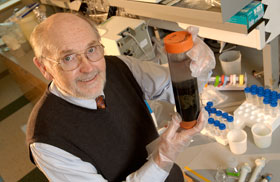  |
| HOME | THIS ISSUE | CALENDAR | GRANTS | BACK ISSUES | < BACK | NEXT > |
UConn scientist’s mercury research underscored by global declarationby Cindy Weiss - March 26, 2007 | ||||
| A new warning by scientists that mercury pollution is a serious global threat underscores the need to study mercury cycling in marine ecosystems, says William Fitzgerald, Board of Trustees Distinguished Professor of Marine Sciences, a leading mercury expert. “Finally, we’ve gotten the broad mercury community to recognize the importance of the marine environment in mercury cycling,” he says. Fitzgerald is one of the scientists supporting the new “Madison Declaration on Mercury Pollution,” a result of the 8th International Conference on Mercury as a Global Pollutant, which took place last summer at the University of Wisconsin. The declaration was published March 8 in the international science journal Ambio. To date, most of the research on mercury contamination in the environment has been terrestrial. Fitzgerald’s research on the other hand, which is supported by the National Science Foundation and the Environmental Protection Agency, has focused on mercury ecosystems such as Long Island Sound. He also is exploring tundra lakes and watersheds in Arctic Alaska and elsewhere. He is considered one of the foremost experts on the chemistry of mercury from an oceanographic and environmental perspective. The mercury declaration reflects the consensus of more than 1,100 scientists at last year’s International Conference on Mercury as a Global Pollutant that:
The group also found that the unregulated use of mercury in small-scale gold mining is polluting thousands of sites around the world and posing risks to 50 million people in mining regions. Methylmercury is the highly toxic form of mercury. It forms principally in the sediment of aquatic systems.
Scientists at the conference based their declaration on the work of four panels that examined various aspects of the mercury threat. Fitzgerald was on the panel for “Source Attribution of Atmospheric Mercury.” The scientists were seeking consensus about what is known, what is uncertain, and what research is needed about mercury. “There was a growing sense that we needed to synthesize the state of knowledge about mercury and contamination,” he says “This is the first time it’s recognized generally that we need to pay more attention to mercury cycling in the marine environment.” Work by Fitzgerald, his students, and colleagues shows that the near-shore region and the continental shelf are major sources of methylmercury to the oceans. Fitzgerald has been conducting studies since 1999 in Arctic lakes, which are far from industrial pollution but still show as much methylmercury accumulating in sediments as Long Island Sound. Methylmercury produced in sediment is photochemically destroyed by sunlight, a process that he is studying. As warming occurs in the Arctic and the permafrost melts, it is possible that more methylmercury will be produced there naturally from increased weathering and plant nutrient contributions, greater phytoplankton production, and more turbidity in the water, which would reduce the penetration of sunlight. It could also lead to more methylmercury accumulation in organisms, he notes. The good news about industrial contamination is that the amount of mercury in the air does not seem to be changing, in spite of increasing contamination in developing countries, says Fitzgerald. It may be that environmental precautions taken by developed countries are compensating for emissions now coming from industrial sites in Asia, Africa, and India. |
| ADVANCE HOME UCONN HOME |

